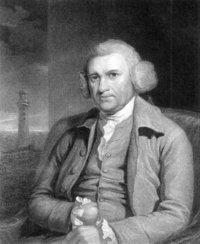John Smeaton
|
|
John Smeaton (8 June 1724 - 28 October 1792) was a civil engineer - indeed, he is often regarded as the 'Father of civil engineering’ – responsible for the design of bridges, canals, harbour and lighthouse. He was also a more than capable mechanical engineer and an eminent physicist. He was associated with the Lunar Society.
| Contents |
Law and physics
He was born at Austhorpe near Leeds, West Yorkshire, England. After studying at Leeds Grammar School, he joined his father's law firm, but then left to become a mathematical instrument maker (working with Henry Hindley), developing, among other instruments, a pyrometer to study material expansion and a whirling speculum or horizontal top (a maritime navigation aid).
He was elected a Fellow of the Royal Society in 1753, and in 1759 won the Copley Medal for his research into the mechanics of waterwheels and windmills. His paper addressed the relationship between pressure and velocity for objects moving in air, and his concepts were subsequently developed to devise the 'Smeaton Co-efficient'.
Civil engineering
Recommended by the Royal Society, Smeaton designed the third Eddystone Lighthouse (1755-59). He pioneered the use of 'hydraulic lime' (a form of concrete) and developed a technique involving dovetailed blocks of granite in the building of the lighthouse. His lighthouse remained in use until 1877 when it was dismantled and partially rebuilt at Plymouth Hoe.
Deciding that he wanted to focus on the lucrative field of civil engineering, he commenced an extensive series of commissions, including:
- The Eddystone Lighthouse (1755-59) - the third such lighthouse to stand on this site, remaining in use for over a century
- the Calder and Hebble Navigation (1758-70)
- Coldstream Bridge over the River Tweed (1762-67)
- Improvements to the River Lee Navigation (1765-70)
- Perth bridge over the River Tay (1766-71)
- Ripon Canal (1766-1773)
- the Newark Viaduct over the River Trent in Nottinghamshire (1768-70)
- the Forth and Clyde Canal from Grangemouth to Glasgow (1768-77)
- Banff harbour (1770-75)
- Aberdeen bridge (1775-80)
- Peterhead harbour (1775)
- Harbour works at Ramsgate (retention basin 1776-83; jetty 1788-1792)
- Hexham bridge (1777-90)
- the Birmingham and Fazeley Canal (1782-89)
- St Austell's Charlestown harbour in Cornwall (1792)
Because of his expertise in engineering, Smeaton was called to testify in a court for a case related to the silting-up of the harbour at Wells-next-the-Sea in Norfolk in 1782. He is considered to be the first expert witness to appear in an English court.
Mechanical engineer
Employing his skills as a mechanical engineer, he devised a water engine for the Royal Botanic Gardens at Kew in 1761 and a watermill at Alston, Cumbria in 1767 (he is credited by some for inventing the cast iron axle shaft for waterwheels). He also improved Thomas Newcomen's atmospheric steam engine, erecting one at Chasewater mine in Cornwall in 1775.
Legacy
Highly regarded by other engineers, he contributed to the Lunar Society and founded the Society of Civil Engineers in 1771 (he coined the term civil engineers to distinguish them from military engineers graduating from the Royal Military Academy at Woolwich). After his death, the Society was renamed the Smeatonian Society, and was a forerunner of the Institution of Civil Engineers, established in 1818.
His pupils included canal engineers James Brindley and William Jessop and architect and engineer Benjamin Latrobe.
He died after suffering a stroke while walking in the garden of his family home at Austhorpe, and was buried in the parish church at Whitkirk, West Yorkshire.
He is mentioned in the Leeds-based "Kaiser Chiefs" song, "I Predict a Riot", as a symbol of a more dignified and peaceful epoch in Leeds history.
John Smeaton also lends his name to an inner city high school currently in the vicinity of where he was born and died. The school has however recently fallen upon hard times and has been cited numerous times in the list of least improved schools in the country.de:John Smeaton

